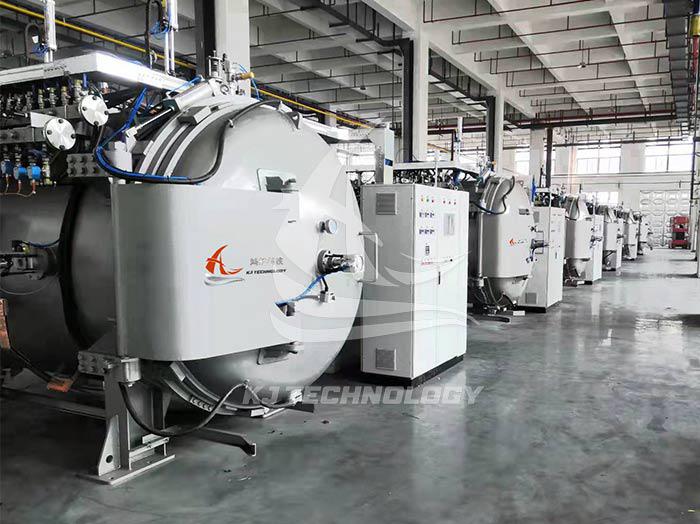Experimental vacuum hot pressing furnace for ceramic processing
 09-22-2025 Author: KJ technology
09-22-2025 Author: KJ technology
The experimental vacuum hot press furnace can significantly improve the density and performance of ceramic materials through the synergistic effect of vacuum, high temperature, and high pressure when processing ceramic materials. Its core application scenarios, technical advantages, and typical processes are as follows:
1. Core application scenarios
Preparation of high-density ceramics
Applicable materials: high-performance ceramics such as boron carbide (B ₄ C), silicon carbide (SiC), silicon nitride (Si ∝ N ₄), zirconia (ZrO ₂), etc.
Typical case:
Boron carbide has a relative density of only 80% -87% when sintered at atmospheric pressure between 2250-2300 ℃, while hot pressing sintering can reach a relative density of 91.6% in 10 minutes at 2150 ℃, and the room temperature Young's modulus increases to 292.5 GPa.
Aluminum nitride (AlN) raw material and copper foil are bonded with high strength through vacuum hot pressing, used for heat dissipation of high-power LED or IGBT modules.
Manufacturing of ceramic composite materials
Multilayer Ceramic Capacitor (MLCC): Dozens of layers of ceramic raw materials are alternately stacked with internal electrodes (Ni, Cu), vacuum hot pressed and co fired to achieve miniaturization and high capacity.
Solid state battery electrolyte membrane: Ceramic electrolyte membrane is composite with electrode material, forming a high ion conductivity interface after vacuum hot pressing.
Ceramic metal heterojunction connection
Solid phase diffusion bonding: Ceramics and metals (such as copper and titanium) are in close contact under high temperature and pressure, and atoms diffuse to form high-strength joints, suitable for high-temperature and corrosion-resistant environments.
2. Technical advantages
inhibiting grain growth
Hot pressing sintering promotes particle rearrangement and grain boundary diffusion through external pressure, which can achieve densification at lower temperatures and avoid grain coarsening caused by high temperatures. For example, the hot pressing sintering temperature of boron carbide is 50-100 ℃ lower than atmospheric pressure, and the grain size is significantly reduced.
Eliminate pores and defects
A vacuum environment (10 ⁻³~10 ⁻² Pa) can eliminate adsorbed gases and volatiles in ceramics, reducing the porosity after sintering. For example, when alumina ceramics are sintered in a hydrogen atmosphere, vacuum hot pressing can reduce the porosity.
Promote interface integration
Under pressure, the contact area between ceramic particles and metal substrates increases, the diffusion of interface atoms accelerates, and stable chemical or physical bonds are formed.
Process flexibility
Support multi-stage heating, pressurization, and atmosphere control to meet the composite requirements of different materials. For example, transparent alumina ceramics are sintered in a hydrogen atmosphere, while nitride ceramics need to be completed in a nitrogen atmosphere.
3. Typical process flow (taking ceramic raw material sheet as an example)
Raw material preparation: Mix ceramic powder (such as Al ₂ O ∝, ZrO ₂) with organic binder and cast it into a film, then cut it into the desired shape.
Stacking and alignment: Stack the raw material sheet and substrate (such as metal foil) in order, with an error controlled within 0.1mm.
Vacuum pumping and heating: Close the hot pressing chamber, evacuate to 10 ⁻ Pa, and heat up at a rate of 1-5 ℃/min to the sintering temperature (such as 800-2000 ℃).
Pressurization and holding: Apply 5-30 MPa pressure to promote particle rearrangement and grain boundary diffusion, and adjust the holding time according to the material thickness (usually 10-60 minutes).
Cooling and demolding: Maintain pressure until the temperature drops below the glass transition point to avoid stress cracking, and then remove the composite film for secondary processing.
4.Equipment selection suggestions
Temperature range: Select according to the characteristics of ceramic materials, such as boron carbide requiring 2200 ℃ or above, and silicon nitride requiring 1700-1800 ℃.
Pressure system: The servo electric control pressure accuracy can reach ± 100N, suitable for high-precision composite material preparation.
Vacuum degree: The cold state limit vacuum degree should be lower than the target, with a small pressure rise rate to ensure thorough removal of gas impurities.
Control system: PLC+touch screen supports multi-stage program heating, with temperature control accuracy of ± 1 ℃ and small displacement accuracy.
Safety design: equipped with functions such as over temperature protection, circuit breaker protection, and leakage protection to ensure operational safety.








